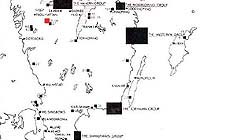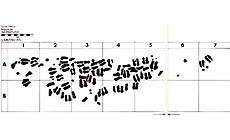|
|
 |
 |
Country: |
Sweden |
Locality: |
Godegård 2 |
|
 |
Region: |
Västergötland |
Area: |
Fåglum |
|
 |
 |
|
|
|
|
| |
 |
Environment & Surface |
 |
 |
 |
|
Open-air
Shelter
Cave
Portable
Megalithic
|
Geography: |
Low, flat ridge 170 m WNW of Fåglum Godegården 1:15, 7 km NE of road to Södra Härene-Nossebro. |
Proximity: |
1,4 km WSW, 80 m E of the farm Fåglum Sörgården 7:20 there are a stone cyst, rebuilt to a cellar, with a circle figure and a cup mark at the N 1,8 high and 1,6 wide gable rock. |
|
 |
Geology: |
|
Surface: |
Low, flat ridge. |
|
|
|
|
 |
 |
|
|
|
|
| |
 |
Art |
 |
 |
 |
Description: |
Engravings
Paintings
Painted engravings
High or low-relief
Sculpture
Godegård, Fåglum parish, Västergötland. The carvings are found on a rather low, flat ridge. The figures are depicted concentrated to the same area. There are 74 foot prints, totally carved out. About 30 are depicted in pairs, and they are surrounded by cup marks. The carving are painted.
|
Figures: |
total number 92
74 foot prints
16 cup marks
|
|
 |
Chronology: |
Palaeolithic
Epipalaeolithic - Mesolithic
Neolithic
Copper Age
Bronze Age
Iron Age
Roman
Middle Age
Modern
Unknown
The South Scandinavian rock carvings are usually dated to the middle and later part of the Bronze Age, c. 1500-500 BC, after Montelius six period system, but no detailed chronology can usually be worked out. The cup marks have been created from the Stone Age and also during the Early Iron Age.
|
Notes: |
The province of Västergötland is comparatively poor off for figurative rock carvings, but rich in carvings with cup marks only. The frequency of cup mark areas generally accords with the distribution of prehistoric grave monuments from all periods, and not especially with those from the Bronze Age. One interpretation of the cup mark is that it was introduced together with megalithic ideas during the Neolithic period and that it prevailed during the Bronze Age. Traditions of domestic cup mark cult for household requirements are also known from later periods. The cup mark cult goes back to very old traditions - possibly related to the cult of the Mother Goddess. Notable are the cases when a cup mark is placed between the foot soles when placed in pair, maybe an indication of female or fertility (Selinge 1989:138f). |
|
 |
 |
|
| |
 |
Bibliography |
 |
|
|
|
|
| |
 |
Conservation |
 |
 |
 |
Status: |
Public
Private
Park
Classified site
|
Risk: |
The major risk for carvings are chemical weathering, which makes the hard quartzite losen up and fall out, leaving white dots on the darker rock surface. Also natural weathering (mechanical weathering) during winter/spring, when water freeze in cracks and openings in the rock, creates major damage to rock faces with carvings. The biological weathering is also a danger to the rock carvings, and even to intense cleaning of the rock surface during documentation can make the rock fragile and expose the carvings to wind, water and air-born pollution. |
|
 |
Conservation: |
Good
Quite good
Mediocre
Bad
|
Intervention: |
Problems concerning conservation and preservation, registration and documentation of rock carvings in Scandinavia are discussed by several departments, i.e. Riksantikvaren in Norway, Riksantikvarieämbetet in Sweden, several universities and research departments. Different methods are tested, for example covering of carved surfaces, measuring of temperature and different contents in water and air and also the composition in the granite. Hollows and cracks in the rock surface can be repaired and carefully filled in. An easy method of taking care of the rock surface is by ordinary sweeping. |
|
 |
 |
|
|
 |
By |
 |
|
| |
| Record n. 762 / 807 |
No commercial use is allowed. Specific © is mentioned in the captions or owned by each Author or Institution |
|
| |
 |
EuroPreArt, European Prehistoric Art, is a web-based archaeological project funded by the European Union which aims to establish a lasting data-base of European prehistoric art documentation, to launch the base of an European institutional network and to contribute to the awareness of the diversity and richness of European Prehistoric Art.
It is proposed by: Instituto Politécnico de Tomar (IPT, Portugal),
CUEBC - European University Centre for Cultural Heritage (Italy - Europe),
Consejo Superior de Investigaciones Científicas (España),
Asociación Cultural Colectivo Barbaón (España),
Université de Liège (Belgique),
Gotland University College (Sverige),
University College Dublin (Eire),
Cooperativa Archeologica Le Orme dell'Uomo (Italia),
Study Centre and Museum of Prehistoric Art of
Pinerolo (Italia),
The European Centre for Prehistoric Research in the Alto Ribatejo (Portugal),
ArqueoJovem - a youth NGO (Portugal).
|
|
|
|
 |
|
 NEW: Alpine rock paintings
NEW: Alpine rock paintings

